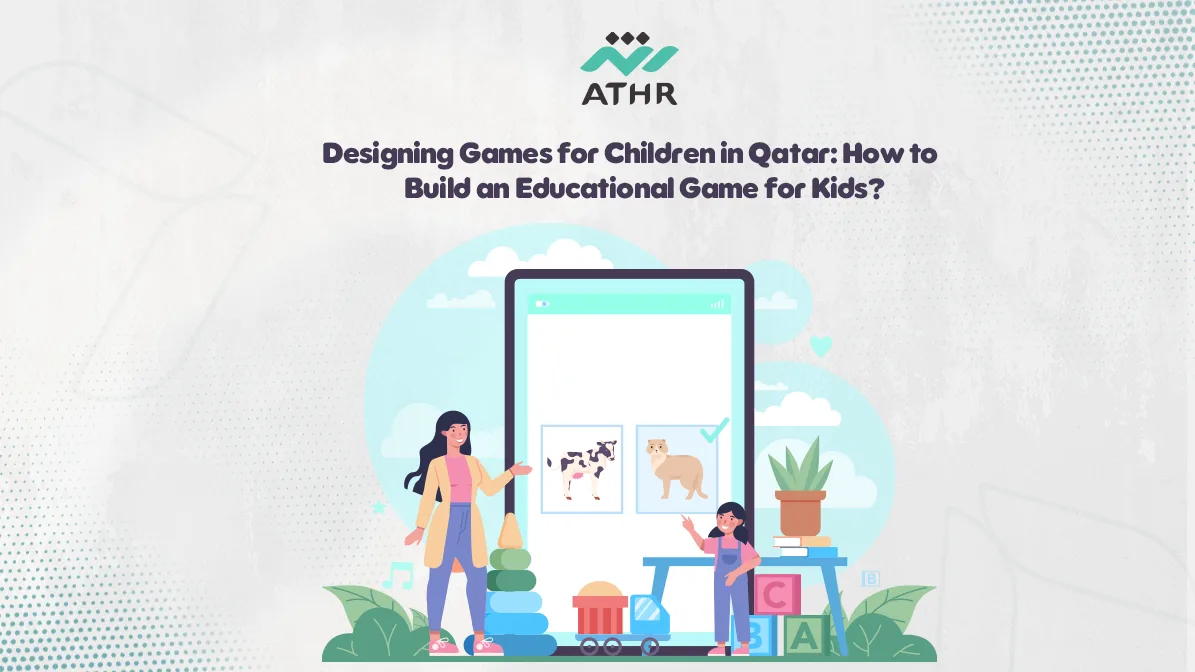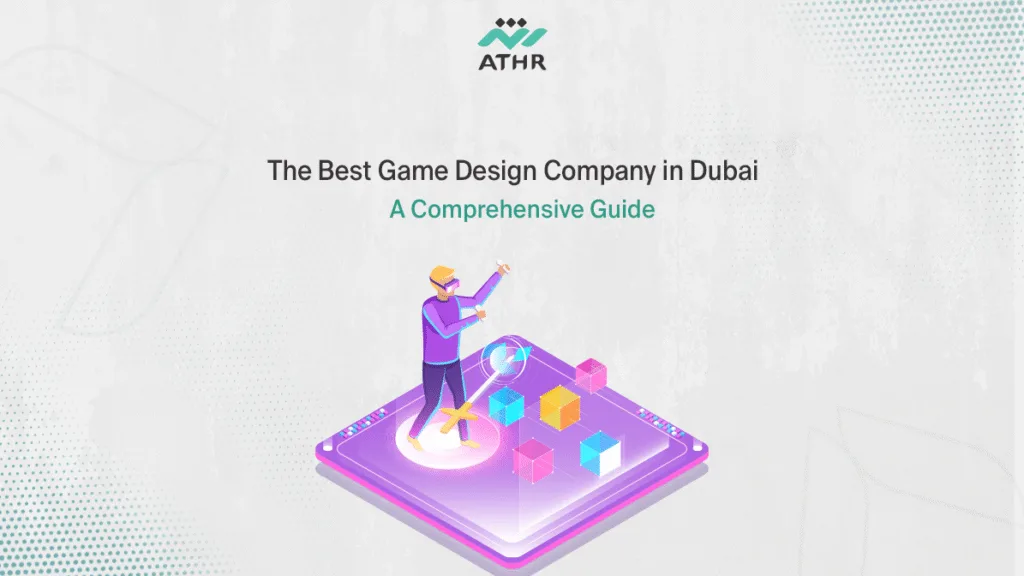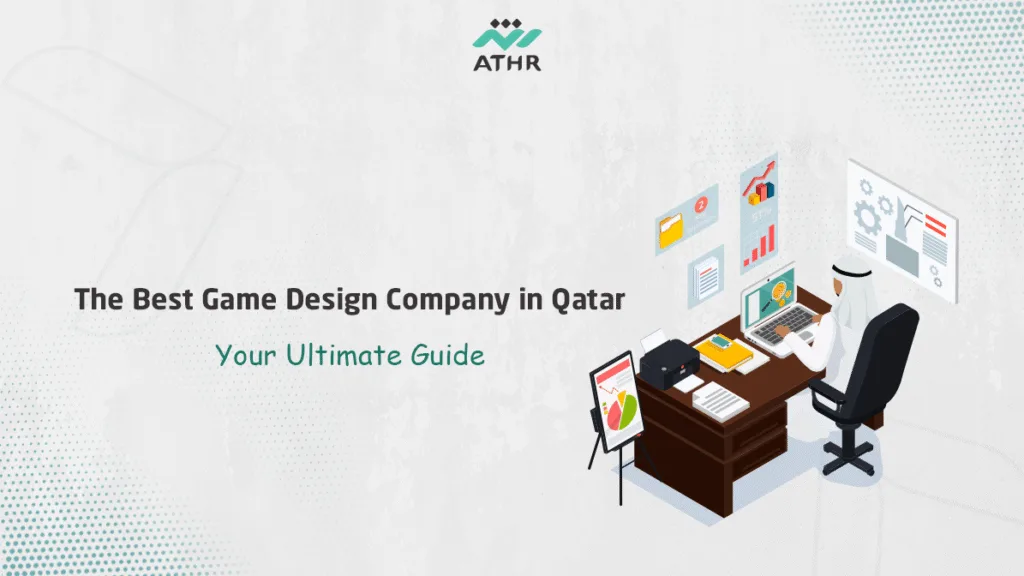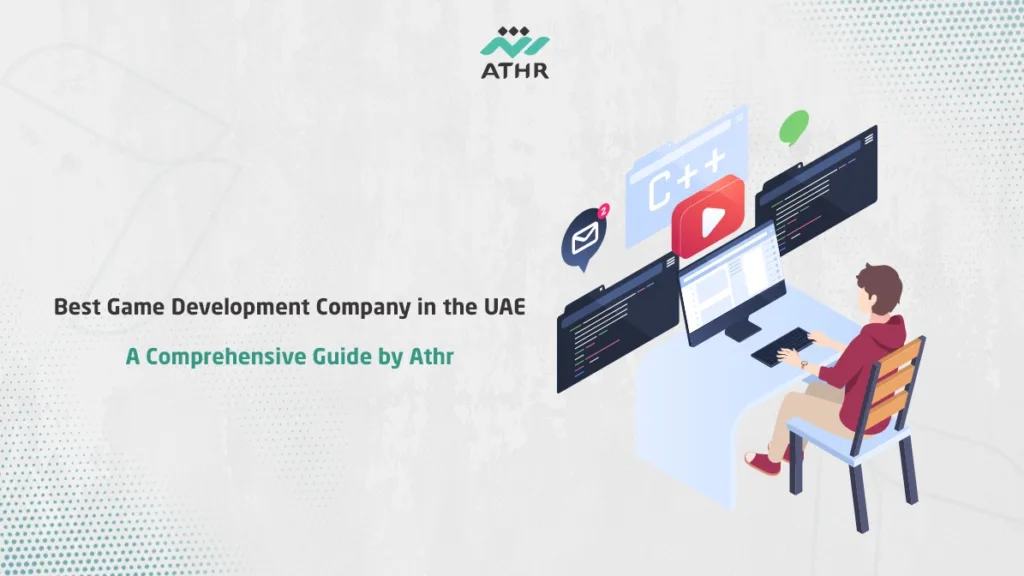Imagine a child in Qatar learning math or language through a fun game on their tablet. They tap, create, and laugh—and with every step, they gain new knowledge without feeling bored. This is the essence of designing games for children in Qatar: transforming learning into an experience full of fun and interaction. We will reveal how you can build a successful educational game that develops children’s skills and combines education with entertainment, with the experts at Athr Company.
📱Start your digital educational project today with Athr – your trusted partner in educational game development.
جدول المحتوي
- The Role of Educational Game Design in Supporting Modern Education in Qatar
- Best Educational Game Programming Companies in Qatar for 2025
- How to Start Designing Games for Children in Qatar Step-by-Step?
- What Makes an Educational Game Successful and Engaging for Children?
- Tips for Building a Successful Educational Game That Attracts Children and Parents
- How do I start designing an educational game for children in Qatar?
- Why do I need a specialized company to develop an educational game for children?
- What is the cost of designing games for children in Qatar?
- How can educational games develop children's skills?
- What is the difference between designing entertainment games and designing educational games?
- Can I make a profit from designing an educational game for children?
- What is the best company for designing games for children in Qatar?
The Role of Educational Game Design in Supporting Modern Education in Qatar
The design of educational games for children in Qatar forms a pivotal part of the modern education system. These games integrate academic concepts with interactive methods that stimulate curiosity and the desire to learn.
Modern Qatari schools aim to use technology to make the educational process more engaging and effective, and educational games are the key to this transformation.
How Educational Games Support the Qatari Education System?
- Promoting Self-Learning: Encourages the child to explore knowledge independently through play.
- Enhancing Digital Skills: Helps develop children’s ability to interact with modern technology.
- Transforming Curricula into an Adventure: Instead of traditional memorization, the child lives an interactive learning experience full of challenges and rewards.
📊 According to digital education reports in the Middle East, over 68% of Qatari schools have begun adopting learning solutions based on digital games in recent years.
How Educational Games Help Develop Thinking and Creativity Skills?
Educational games aren’t just teaching tools; they are laboratories for creativity.
When designing an educational game for children, elements that stimulate analysis, experimentation, and problem-solving are integrated, which positively reflects on their mental and behavioral capabilities.
Key Skills Developed by Educational Games:
- Critical Thinking: Through interactive situations that require quick decisions.
- Creativity and Innovation: By customizing characters or inventing new solutions within the game.
- Social Skills: Especially in multiplayer games that encourage cooperation and teamwork.
- Focus and Attention: As the child learns how to balance goals and risks within the game environment.
📌 The “Qatar Educational Games Project 2024″ experiment proved that children who used interactive educational games showed a 45% improvement in thinking and problem-solving skills compared to traditional methods.
Why Are Games an Effective Learning Tool in Modern Qatar?
In Qatar, educational games are viewed today as a strategic educational tool, not just an entertainment addition. They combine fun, interaction, and repetition—the three elements proven effective in improving children’s memorization and comprehension.
Main Reasons for the Effectiveness of Educational Games:
- Brain Stimulation: Learning through play activates the thinking and memory areas of the brain.
- Integrating Technology with Education: A national goal that the State of Qatar seeks to achieve as part of its Vision 2030.
- Educational Sustainability: Educational games can be constantly updated to keep pace with the evolution of curricula and future required skills.
- Cultural Integration: Games can be designed to reflect the Qatari environment and local customs in an innovative educational way, making the experience closer to the Qatari child’s heart.
Launch your game world in the UAE –📖 Learn how to design and succeed with Athr’s integrated guide.
Best Educational Game Programming Companies in Qatar for 2025
The market for developing educational games for children in Qatar has been witnessing accelerated growth in recent years, with increasing demand from schools, educational centers, and even parents looking for interactive educational tools to enhance their children’s skills. For this reason, several educational game programming companies have emerged in Qatar, offering innovative solutions that combine education and entertainment.
As 2025 approaches, the competition is becoming more professional; success in this field no longer depends only on ideas, but on technical capability, design creativity, and interaction.
Latest Trends in the Qatari Educational Game Programming Market:
- Adopting Artificial Intelligence (AI) to personalize educational content according to the child’s level.
- Using Augmented Reality (AR) technologies to make learning closer to reality.
- Developing 3D Educational Games that provide an engaging visual experience and stimulate continuous interaction.
- Integrating the Arabic language and the Qatari environment into game design to suit the local identity and address the child in their language and culture.
Criteria for Choosing the Right Company to Develop Your Educational Game
When you decide to design an educational game for children, choosing the right company is the most important step towards success. Not every game developer possesses the necessary pedagogical and technical expertise to build a truly effective educational experience.
Here are the most important criteria to consider before contracting:
- Specialized Experience in Educational Games: Ensure the company doesn’t just program games but understands the mechanisms of learning and interactive behavior in children.
- Possessing an Integrated Team: Including educational designers, professional developers, and User Experience (UX) experts specializing in children’s behavior.
- Diversity of Previous Projects: Review the company’s portfolios in Qatar or the Gulf, especially in the field of educational and interactive reality games.
- Using the Latest Technologies: Such as Unity, Unreal Engine, or Flutter Game SDK to ensure smooth performance and attractive graphics.
- Integration with Educational Curricula: Choose a company that can customize the game to align with Qatari curricula or required educational objectives.
- Post-Development Service: Technical support, updates, and the possibility of developing new stages in the future.
💡Don’t rely on price alone. Professional companies offer long-term educational and artistic value that ensures the game’s success and sustainability.
Why Athr Company is One of the Leading Educational Game Design Companies in Qatar?
Athr Company is one of the leading companies in designing and developing educational games in Qatar, thanks to a unique blend of technical expertise and educational creativity. It doesn’t just build a visually attractive game but focuses on achieving its primary goal: educating children in a fun and effective way.
What sets Athr apart:
- Experience in the Qatari Market: The company has executed projects aimed at schools and educational institutions in Doha and other Qatari cities.
- Multidisciplinary Team: Includes developers and educational designers who integrate education with entertainment into a single experience.
- Use of Latest Game Engines: Such as Unity, Godot, and Flutter Game Engine to provide high performance on mobile and tablets.
- Designs Inspired by Qatari Culture: The company offers educational games that speak in the Qatari child’s dialect and address topics from their local environment.
- Commitment to Safety Standards: All educational games from Athr are designed according to privacy policies and online child protection (COPPA Compliance).
🏆Athr’s team is ready to design your next game – Start now and realize your educational vision!
How to Start Designing Games for Children in Qatar Step-by-Step?
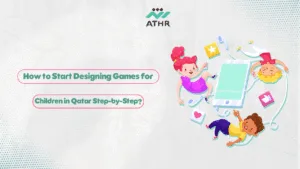
Success in designing educational games for children in Qatar is not achieved by chance; it depends on a well-thought-out plan that combines creativity, educational objectives, and modern technologies. Whether you are a school owner, an educational center, or a startup wanting to develop a distinguished educational game, following a professional design methodology will guarantee you real results and a tangible impact on children.
Here are the most important practical steps to build an interactive educational game for children in Qatar:
Define the Educational Goal and Appropriate Age Group
The first—and perhaps the most important—step is to clearly define the game’s goal.
Do you want to teach children math concepts? Or improve Arabic language skills? Or develop logical and creative thinking? Defining the goal will help you build the story, levels, and challenges to serve the required educational content.
Practical Tips:
- Determine the core educational skill (e.g., counting, reading, critical thinking).
- Choose the appropriate age group, as the gameplay style for a seven-year-old is completely different from a twelve-year-old.
- Make the game relate to the Qatari child’s reality, through familiar characters and places (like the school environment or local heritage).
- Use Gamification techniques such as rewards, stars, and levels to boost learning motivation.
Choose the Tools and Platforms for Developing Educational Games for Children in Qatar
Choosing the right platform is the backbone of any successful game. In the Qatari market, where children rely heavily on smartphones and tablets, the game must be compatible with Android and iOS and easy to run on all devices.
Recommended Tools and Platforms:
- Unity: Ideal for developing 3D or 2D educational games with excellent graphics.
- Flutter Game Engine: A great choice for light and fast-responding educational applications.
- Godot: Open-source and easy to integrate with Augmented Reality (AR) technologies.
- Firebase + Google Analytics: To monitor children’s performance within the game and analyze their learning behavior.
Important Technical Standards:
- Simple user interface and cheerful colors suitable for children.
- Support for the Arabic language and Qatari dialect to enhance interaction.
- Compliance with security and privacy standards (COPPA).
Test the Game with Children and Improve the Educational Experience
After completing the game design, the testing phase begins, which is the stage that shows you whether the game is actually achieving its educational goals or not. Testing with children gives you genuine feedback that helps you improve the interaction, design, and content.
Steps for Successful Game Testing:
- Test the game with a small group of children from the target age group.
- Observe their behavior: Do they show enthusiasm? Do they have difficulty navigating?
- Gather feedback from children, teachers, and parents.
- Make continuous improvements based on the data before the official launch.
How Athr Company Helps You Build a Successful Educational Game?
If you are looking for a reliable software partner to help you turn your idea into an impactful educational game, Athr Company is your ideal choice. Our team includes developers and educational designers who work on every stage—from educational planning to practical testing with children.
What we offer:
- Analysis of the idea and turning it into a realistic, interactive design.
- Building gradual educational stages that consider the child’s abilities.
- Designing fun and safe interfaces.
- Comprehensive testing before launch to ensure the educational goal is achieved.
Before you start your next project… 👀 Check out the best guide for choosing a game programming company in Qatar.
What Makes an Educational Game Successful and Engaging for Children?
The success of any educational game for children in Qatar depends not just on the quality of the programming but on its ability to combine interaction, fun, and education.
A child is naturally curious and loves to explore, and if they don’t feel entertained while learning, they will quickly lose interest.
For your educational game to succeed, it must create a complete experience that blends challenge, visual stimulation, and direct educational content. The goal is for the child to learn without feeling like they are in a “lesson,” but rAthr living a fun educational adventure that leaves an imprint on their memory.
Key Components of a Successful Educational Game:
- Clear Educational Goal: The designer and developer must know what the child will learn at each stage.
- Rewards and Motivation System: Such as points, stars, or virtual certificates that reinforce the child’s achievement.
- Engaging Story: The story helps build an emotional connection between the child and the game, making learning more enjoyable.
- Easy-to-Use Interface: Clear buttons, audio instructions, and a simple, visually comfortable design.
- Immediate Feedback: The child needs to know if their answer is correct instantly, which reinforces the learning process.
Graphics, Sound, and Interaction Elements That Increase Fun and Learning
Educational game design is not just codes and programming; it is a visual and auditory art aimed at attracting the child and stimulating their senses. Graphics and sound elements bring life to every scene within the game and make the educational experience fun and lively.
- Graphics:
- Use bright colors consistent with children’s psychology.
- Make the characters fun and close to Qatari culture, such as characters wearing traditional attire or speaking in a friendly, formal Arabic accent.
- Maintain clarity of visual details without exaggeration to avoid distraction.
- Sound Design:
- Add motivational sounds upon success, such as an applause tone or an encouraging phrase.
- Use cheerful but non-disturbing background music.
- Include educational sounds, such as pronouncing letters or numbers, to increase both auditory and visual interaction.
- Interactivity:
- Add short challenges that require the child’s actual participation, such as drag-and-drop or choosing the correct answer.
- Make the game respond immediately to the child’s actions to give them a sense of control.
- Use continuous motivation elements (Levels – Stars – Progress Bar) to encourage the child to complete learning.
How to Balance Entertainment and Educational Content in Game Design?
One of the most important challenges in designing educational games for children is achieving the balance between fun and education. If the game is too educational, the child might get bored, and if it’s too entertaining, it might lose its pedagogical goal.
Here is the optimal way to achieve this balance:
- Start with the educational content, then wrap it in fun:
Design the lessons first, then seamlessly add fun elements like the story or graphics afterward. - Make every learning step a reward in itself:
Instead of separating “play” from “learning,” make every entertaining task require the application of the necessary educational concept. - Use a system of progressive challenges:
Start the game easy, then gradually increase the difficulty while introducing deeper content in each stage. - Constantly monitor children’s interaction:
Use Analytics tools to know the points that interest them or cause frustration the most, and adjust the design accordingly.
🎯Strong learning in a game is not just in texts or questions, but in the decisions the child makes while playing, such as problem-solving or step-ordering, which greatly enhances experiential learning.
Create a game that makes a difference in children’s lives – 📞 Contact Athr and start your project with confidence.
Tips for Building a Successful Educational Game That Attracts Children and Parents
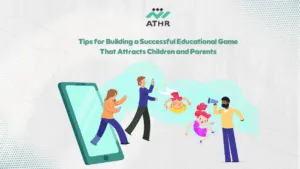
The success of any educational game for children in Qatar depends not just on the quality of the idea but on its ability to attract both children and parents. The child is the direct user, but the decision to purchase or download is often in the hands of parents who look for safe, useful, and easy-to-use content. To achieve this balance, here is a set of tips from Athr Company experts in designing successful educational games.
Balancing Fun with Educational Benefit
The golden key to the success of any educational game is to make learning fun.
The child will not interact with the game if they feel it is a “lesson,” but they will enjoy it when they learn without realizing it. Therefore, the game must combine elements of fun, challenge, and reward within every learning experience.
Effective Steps to Achieve Balance:
- Start with the Story, Not the Curriculum:
Write an engaging story that contains an educational adventure, then subtly incorporate the curriculum content within it. - Use a Smart Rewards System:
Give the child a sense of accomplishment through points, levels, and digital prizes. - Divide Learning into Short Stages:
Make each stage simple and quick so the child doesn’t lose focus. - Integrate Challenges with Benefit:
For example, the child can learn numbers while building a city or recognize letters while solving a fun puzzle.
📊 According to a study by Qatar Learning Analytics 2024, games that integrate education with fun achieve an 82% higher retention rate for children compared to traditional educational games.
Focusing on Safety and Ease of Use
One of the most important factors for the successful development of educational games for children in Qatar is observing digital safety and ease of interaction. Parents in Qatar place a high priority on protecting their children from inappropriate content or random ads, so the game must be trustworthy and secure.
Most Important Safety and Good Design Standards:
- Implementing COPPA and GDPR Kids standards: To ensure the protection of children’s data privacy.
- Removing pop-up ads: As they distract the child and may contain unsafe content.
- Using a Parental Dashboard: Allowing them to monitor the child’s progress and time spent in the game.
- Simple and clear interface design: Where the child navigates easily without the need for constant reading or parental assistance.
- Large buttons and colors: As they encourage the child to interact and feel confident while playing.
Testing the Game with a Group of Children Before Launch
Before your game hits the market, you must ensure it works as you expect—not just technically, but psychologically and behaviorally as well. Testing the game with children gives you real insights into the interaction method, difficulty level, and attraction elements.
Steps for Effective Testing:
- Select a small group of children representing the target age group.
- Observe their gameplay without intervention, to identify points of interaction or confusion.
- Request feedback from parents about behavior, attention, and reactions.
- Adjust the design and content based on the experience before the final launch.
Games pre-tested on children achieved a 68% higher satisfaction rate compared to games that did not undergo realistic testing.
From idea to execution — here’s your complete guide to developing your games using the latest technologies.
Designing educational games for children in Qatar is a smart step toward fun and interactive education that develops a child’s skills and stimulates their imagination. With the support of technical and creative expertise from Athr Company, you can turn your idea into a successful educational game that combines fun and benefit.
Join the list of pioneers in educational game development in Qatar with Athr.

